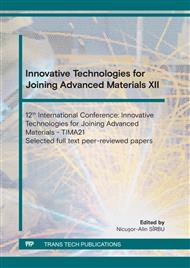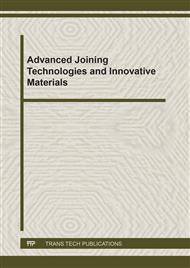p.1
p.9
p.15
p.25
p.35
p.45
p.51
p.57
Aspects Regarding the Operating Behavior of FSW Welding Tools
Abstract:
Welding tools are a determining factor in obtaining welded joints with desired characteristics. The international community pays great attention to research aimed at establishing the optimal characteristics of friction stir welding (FSW) tools. With the development of the FSW welding process with its own contributions, ISIM Timisoara has developed complex research resulting in the conception and design of (innovative) FSW welding tool solutions. A very important factor especially when welding high hardness materials is the durability / lifespan of FSW welding tools. The paper presents general considerations regarding the qualities that FSW welding tools must meet in general, but also ISIM achievements in the field of design and operation of welding tools. Studies regarding operating behavior of welding tools made of sintered tungsten carbide P20S, in terms of service life (wear), both in the case of applying the classical FSW welding process and the method of friction stir welding in inert gas environment (FSW-IG), when joining steels with wide industrial use (304L stainless steel, respectively DD13 steel), are also presented. Concrete data is presented with values of the degree of wear of the tools in the unit of time, in their critical areas: tools made of X38CrMoV5 steel alloy used for welding aluminum alloys with different characteristics, respectively tools made of sintered tungsten carbide P20S used for welding S 235 JR + N steel and 304L stainless steels.
Info:
Periodical:
Pages:
25-33
Citation:
Online since:
June 2022
Authors:
Keywords:
Price:
Сopyright:
© 2022 Trans Tech Publications Ltd. All Rights Reserved
Share:
Citation:



